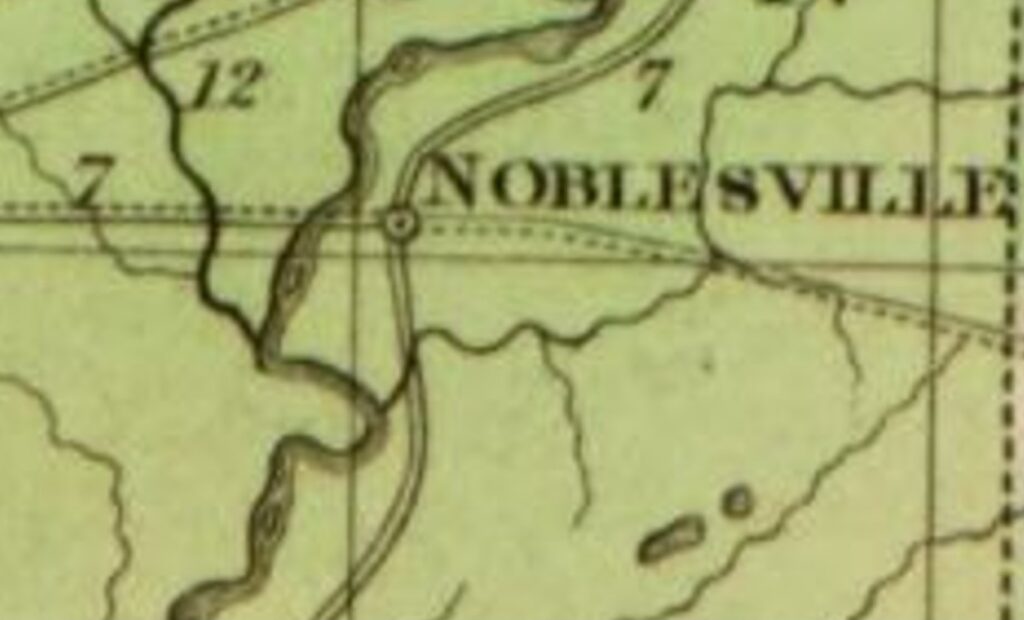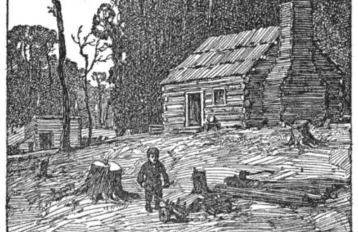By David Heighway, Hamilton County Historian
In the early nineteenth century, the Fourth of July could be considered the most important holiday in the United States. It was a statement of national identity at a time when Americans were still trying to understand who they were. The first celebration in Hamilton County occurred a few years before the county or the town of Noblesville existed. There is a short description of it in Augustus Finch Shirts’ book on the history of the county before the Civil War. Shirts was the son of one of the first non-native settlers, but he was born in 1822, so his description is obviously what he was told by other people.

Detail of 1839 map of Indiana showing Noblesville and Horseshoe Prairie
Credit: World Digital Library
After the land was opened by the 1818 Treaty of St. Mary’s, a settlement was established at Horseshoe Prairie in 1819, an area just south of present-day Noblesville. Shirts writes:
“My father, George Shirts, moved his family from or near the present site of Connersville, on pack horses, to the William Conner place, in the month of March, 1819. On the first day of April, 1819, Solomon Finch, his wife Sarah, his daughters Rebeccah, Mary and Alma, and his sons James and Augustus, then living near the present site of Connersville, left their home for the horse-shoe prairie, two miles southwest of Noblesville. … With them came Israel Finch, Amasa Chapman, James Willason, William Bush and two sons hardly grown. William Bush and Israel Finch were married men, but left their families at their home until cabins could be built for them.”
Not all of those first settlers made it through the first year.
“Some time in August, 1819, probably the last of it, these pioneers were attacked with chills and fever. This resulted mainly from the stagnant water in the ponds. … Men, women and children were all attacked. There were not enough well persons to wait on the sick whilst the chills and the fever which followed lasted. … However, they got along until cold weather, when the sickness subsided.”
“The first graveyard, used exclusively by white people, is situated a little north and west of the point where Solomon Finch’s cabin was built. Two of Curtis Mallory’s children were buried there, two Finches, one Chapman and one Willason—this is all the names I can recall. Coffins were made from walnut timber, split as fine as could well be done. The broad-axe was used to dress the timbers, and they were pinned together with wooden pins. Some small trees indicate the location of this graveyard, south of this settlement.”
However, the next year saw the settlement begin to succeed.
“Early in 1820 Mr. Audrick came to the settlement and built a cabin. James Wilson came about the same time, but he built his cabin on the east side of the river just below the mouth of Stony Creek. About the fourth of May, 1820, Curtis Mallory came to the settlement. In the spring of 1820 John and Israel Finch started a blacksmith shop. The settlement had now assumed considerable proportions and they proposed raising corn on the prairie, and improvements generally began to be made.”

Drawing by Franklin Booth for the book Once Upon a Time in Indiana by Charity Dye.
The first school was organized that year, taught by Sarah Finch. Several of the names mentioned can be found on the 1820 census. There were others there who weren’t on the census. One was Pete Smith, an African American fur trader who had helped the settlers survive the first year. Two others were George Ketchum and his son Charles. They were Lenape (Delaware) Indians who decided to stay after the rest of the tribe left. They had also helped the settlers that first year.
No celebration of the Fourth had been done the first year as survival took precedence. However, in 1820, proper recognition was done and was described later by Shirts:
“The Fourth of July was celebrated this year by the reading of the Declaration of Independence, making speeches and the singing of patriotic songs. When this was over a dance was proposed. So all hands went to work with a will, building a bower of bushes and clearing the ground, under the bower, of all obstructions, and thereupon the dance was enjoyed by all. The settlers raised a fine crop this year. One or two persons settled at Strawtown in 1820 and a great many at Indianapolis, so they found sale for their crop at fair prices.”
It’s not clear how music was supplied for the dance, as the settlement’s only known musician had died of fever in 1819. However, it’s evident that a good time was had by all. The settlers may have felt that there was a bright future ahead and that celebrating the birth of their country was the best way to express it.
Unfortunately, that wasn’t what happened. They soon lost their lands. Shirts says:
“These lands were placed on the market in 1822. … John Conner lived at Connersville and was wealthy. He secured the numbers of all the lands selected and improved by these pioneers, except Lacy and Willason, and entered all of it. The first the settlers knew of this was notice by Conner for them to vacate. They had cleared, fenced and broken about 300 acres of land, and it is said that John Conner refused to pay for any of the improvements.”
In addition to this, a visiting land speculator claimed that Pete Smith was a runaway slave, and Smith was captured and taken south. Later, the Ketchums left to join the rest of the Lenape tribe west of the Mississippi River.
So, while the future wasn’t what the settlers may have been expecting, the county continued to grow, and people found a home here. 224 years later, they still enjoy celebrating the Fourth of July.
